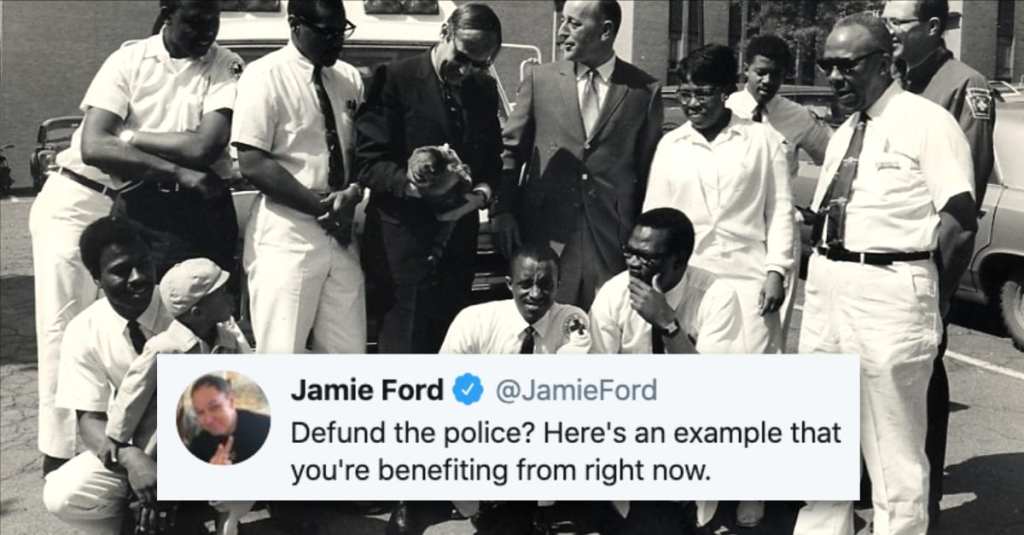Since the George Floyd protests began, defunding the police has become a hot button topic. But what does it really mean?
It’s no secret that systemic racism and police brutality go hand in hand, and law enforcement across the United States has needed a change for some time. The police have been militarized since the early 2000s, with billions of dollars going toward the purchase of military gear for local cops.
Some believe that the money could go toward services to better serve the community, which will help cut down on crime, but others think there’s no turning back, and the cops need all the help they can get.
Twitterer Jamie Ford has explained why he thinks this is such a controversy. He notes that it has happened before and we’re still reaping the benefits. Let’s go back to the 1970s.
Ambulance services, he explains, were once run by reluctant police and firefighters.
Until the 70s, ambulance services were generally run by local police and fire departments. There was no law requiring medical training beyond basic first-aid and in many cases the assignment of ambulance duty was used as a form of punishment. 2/9
— Jamie Ford (@JamieFord) June 14, 2020
This didn’t serve communities properly—particularly minority communities.
As you can imagine, throwing people with medical emergencies into the back of a paddy wagon produced less than spectacular health outcomes. Now imagine how much worse it became when disgruntled white police officers were demoted to ambulance duty in black neighborhoods. 3/9 pic.twitter.com/mzzp1T6huW
— Jamie Ford (@JamieFord) June 14, 2020
In 1967, Pittsburgh residents had had enough and approached someone in the medical community for help.
The response was so problematic that in 1967, black leaders in Pittsburgh’s Hill District, created Freedom House Ambulance Services and approached Peter Safar, a doctor at the University of Pittsburgh, who had lost his 12-year-old daughter to an acute asthma crisis. 4/9 pic.twitter.com/CvFhvoy3cD
— Jamie Ford (@JamieFord) June 14, 2020
They found a doctor who trained residents on CPR and other life-saving measures.
With a shared purpose of improving emergency medical response, Safar trained 25 black men from that neglected community––many of whom did not have a high school diploma––as emergency medical technicians, skilled in this new thing called CPR. 5/9 pic.twitter.com/yxpwBVZOgr
— Jamie Ford (@JamieFord) June 14, 2020
That was when the first independent ambulance service in the U.S. began.
With two donated police vehicles, Freedom House Ambulance Services began to save lives at such a rate, that they became the gold standard for emergency response training in the US and the model for EMTs we now take for granted in every community. 6/9 pic.twitter.com/NHrN4Ly7Mm
— Jamie Ford (@JamieFord) June 14, 2020
The service worked so well that it was called into other neighborhoods.
Freedom House paramedics were so dynamic in their ability to respond to the critically ill that the Pittsburgh police often called them for high acuity cases in white neighborhoods. 7/9 pic.twitter.com/4B5wwVycY6
— Jamie Ford (@JamieFord) June 14, 2020
Local police and fire departments saw this and put money into training for proper EMTs.
Despite the success of FHAS, police and fire departments resisted retraining their personnel, so the city reallocated funds to create a separate EMT service. (A new mayor cut funding to Freedom House in 1975 and seized their assets, but that’s another story). 8/9 pic.twitter.com/2xTUa8B0qA
— Jamie Ford (@JamieFord) June 14, 2020
When you hear about defunding the police, that doesn’t mean not having police; it means using some of that money to support the community in innovative and far-reaching ways.
How do you think your community could be better served by local government? Do you understand what people think “defund” the police mean now?
Let us know in the comments below!






